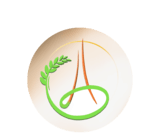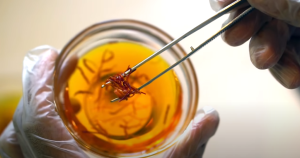Saffron, known commercially as the dried red stigmas of the Crocus sativus L. flower, is highly valued for its ability to enhance the color, flavor, and aroma of various food dishes and drinks (2).
Saffron’s quality is crucial for consumers in the food industry. It is determined by the concentration of its apocarotenoids and their respective sensory attributes, including crocin’s coloring strength, picrocrocin’s bitter taste, and safranal’s aromatic intensity. Saffron contains a wide range of volatile and non-volatile compounds, such as proteins, carbohydrates, vitamins and other compounds [4]. However, it is the apocarotenoids (crocin, picrocrocin, and safranal) that are responsible for saffron’s sensory characteristics and serve as the main bioactive compounds used as markers for its quality. Additionally, the estimation of its coloring power, bitter taste, and aroma plays a significant role in determining saffron’s quality and commercial value [3].
The ISO 3632 standard has been established to assess the main apocarotenoids present in saffron using a spectrophotometric method. This method offers advantages such as ease of preparation, accessibility, and affordability in terms of equipment. However, it has limitations that can lead to inaccurate results. These include overlapping chemical compounds, poor solubility of safranal, incorrect quantification of compounds, and inability to detect adulterants. As a result, the ISO standard should only be used as an initial screening tool to exclude low-quality saffron and is not suitable for authentication or detecting adulteration. For accurate quantification of saffron apocarotenoids, more rigorous analytical techniques are preferred.
The techniques, such as Chromatography (both gas and liquid) combined with spectral fingerprinting or chemo typing are essential for identifying genuine saffron. These techniques offer greater sensitivity, selectivity, and accuracy in determining precise concentrations. In conclusion, while the ISO 3632 standard serves as a starting point for assessing saffron quality based on its apocarotenoid content, more advanced analytical techniques are necessary for accurate quantification and authentication (1).
Refrences:
1- Avila-Sosa, R., Nevárez-Moorillón, G.V., Ochoa-Velasco, C.E., Navarro-Cruz, A.R., Hernández-Carranza, P. and Cid-Pérez, T.S., 2022. Detection of saffron’s main bioactive compounds and their relationship with commercial quality. Foods, 11(20), p.3245.
2-Cardone, L., Castronuovo, D., Perniola, M., Cicco, N. and Candido, V., 2020. Saffron (Crocus sativus L.), the king of spices: An overview. Scientia Horticulturae, 272, p.109560.
3-de Castro, M.L. and Quiles-Zafra, R., 2020. Appropriate use of analytical terminology–examples drawn from research on saffron. Talanta open, 2, p.100005.
4-Hadavi, R., Jafari, S.M. and Katouzian, I., 2020. Nanoliposomal encapsulation of saffron bioactive compounds; characterization and optimization. International Journal of Biological Macromolecules, 164, pp.4046-4053.

